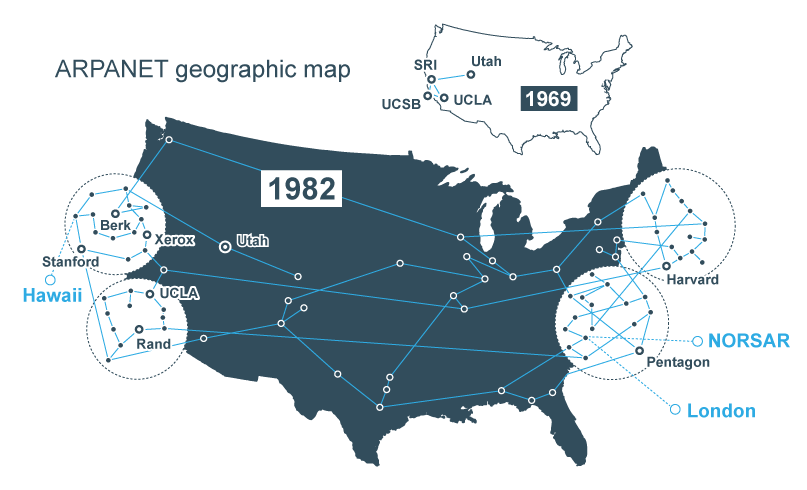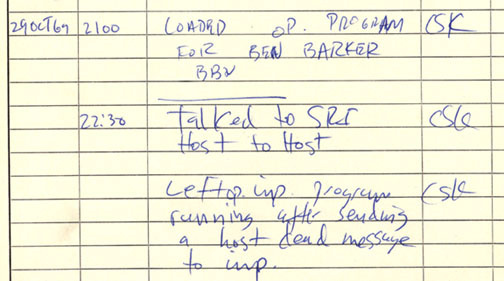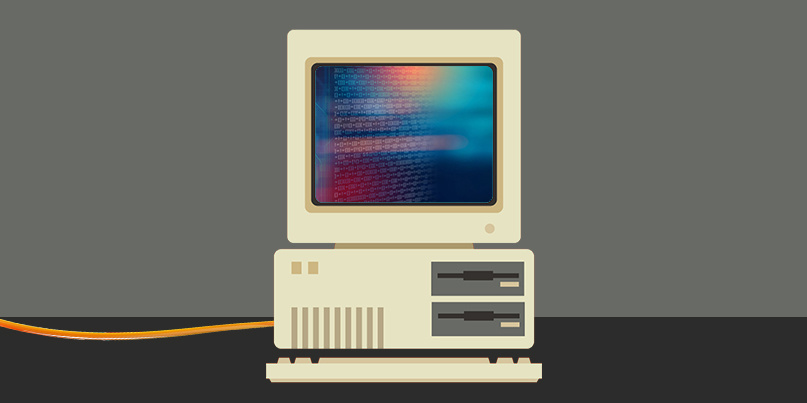what were the first four locations hooked up to the internet (arpanet)?
How history was made

The Advanced Research Projects Agency Network (ARPANET) – the precursor to the mod internet – marks its 50th ceremony today (October 29).
To celebrate this landmark occasion, The Daily Swig provides a rundown of ARPANET and how it laid the groundwork for the modern internet and today'due south hyper-connected earth.
What is ARPANET?
ARPANET was an experimental arrangement that pioneered the then-radical thought of networking different kinds of computers together.
The project was sponsored past the U.s.a. Defense force Department's Advanced Research Projects Agency (then known every bit ARPA but since renamed as DARPA).
 The evolution of ARPANET, 1969-1982
The evolution of ARPANET, 1969-1982
How did ARPANET work?
ARPANET initially connected four contained network nodes situated at Academy of California, Los Angeles (UCLA), Stanford Research Plant (SRI), the University of California-Santa Barbara (UCSB) and the University of Utah.
The beginning node of the ARPANET was established when networking hardware was installed to UCLA and connected to a host computer on September 2, 1969, simply its birthdate is taken from when the offset transmission was made, October 29, 1969.
The team of engineers at UCLA was led by Professor Leonard Kleinrock and featured immature graduate student Vint Cerf.
Cerf after teamed with young man engineer Bob Kahn to create the TCP (Transmission Command Protocol)/IP protocol suite.
What was the outset ARPANET message?
The first ARPANET message sent using the prototype package switching network was a failed attempt to simulate a basic login process.
Ii characters – 'L' and 'O' – typed into a estimator terminal at UCLA were successfully transmitted to a computer at the Stanford Research Institute, some 352 miles (566 km) abroad, before the connection was lost.
Scientists had intended to blazon in "LOG" through an "Interface Message Processor", just UCLA undergraduate Charley Kline only got as far equally sending two characters before the organisation crashed.
The exercise was repeated successfully a few hours subsequently.

The first ARPANET message was sent on October 29, 1969
Who supplied the technology?
AT&T supplied the 50kbps connection between the 2 sites, with engineers gear up up an counterpart phone phone call to ostend the receipt of messages.
Authorities contractor BBN supplied the Interface Bulletin Processor (IMP) that connected nodes on the nascent network. Each IMP comprised a Honeywell DDP-516 mini-computer with 12KB of memory. This gateway allowed a host machine at UCLA (an SDS Sigma vii running the Sexual activity operating system) to send a message to a final at SRI (an SDS-940 computer with the Genie operating system).
The October 29, 1969, communication was significant considering it represented the first use of a wide area parcel switched network, a pioneering communications engineering science that nevertheless underpins modern telecommunications networks.
Packet switching, which works without a defended aqueduct, created a much more flexible and resilient networking compages than earlier circuit-switched systems. In a packet switching network, letters are cleaved up and sent as detached packets that are reassembled at their destination, often having travelled via different routes and over different mediums (landline, radio, satellite, etc.)
How did ARPANET go the internet?
ARPANET went international in 1973 with satellite links linking the University College of London in England and the Imperial Radar Institution in Kingdom of norway to US universities.
Access to the ARPANET was further expanded in 1981, when the US National Science Foundation (NSF) created the Informatics Network (CSNET). This eventually led to the cosmos of the NSFNET project in 1986.
This laid the groundwork for the cosmos of the cyberspace as we now know it.
 ARPANET was the precursor to the modernistic internet
ARPANET was the precursor to the modernistic internet
When did ARPANET end?
The ARPANET project disbanded in 1990, but project helped seal partnerships within the telecoms industry that laid the groundwork for the creation of the modern internet and the Earth Wide Spider web.
How is the ARPANET 50th anniversary being historic?
An anniversary event celebrating the 50th anniversary of the ARPANET is taking place at UCLA later today (October 29).
The event will feature a chat between UCLA computer science professor Leonard Kleinrock; Vint Cerf, chief cyberspace evangelist at Google; Steve Crocker; Charles Kline, an net technology and network security consultant; and Bill Duvall, formerly of Stanford Research Institute.
Robert Metcalfe, entrepreneur and co-inventor of Ethernet and Steven Walker, director of DARPA is as well due to speak.
ARPANET history: Paving the style for a continued digital world
Oct 29, 1969
ARPANET, the precursor of the modern net, goes live.
1972
The starting time electronic mail program, written past Ray Tomlinson, becomes a killer app on the fledgling ARPANET, which by the terminate of the years had expanded to connect 24 sites.
1973
Satellite links to Hawaii, the University College of London in England, and the Regal Radar Establishment in Norway established. ARPANET goes international across 37 sites.
1974
Vint Cerf and Bob Kahn publish a paper, A Protocol for Package Network Intercommunication (PDF), that outlines the design for a Transmission Control Programme (TCP).
1980
ARPANET suffers its kickoff outage on grinds October 27. The trouble is traced to an accidentally propagated status-message virus.
1983
Switch over from the host-to-host Network Control Protocol (NCP) to TCP/IP, every bit the underpinning network technology.
The ARPANET is split with the creation of a military-only (MILNET) and civilian sections.
1986
NSFNET established with a backbone speed of 56 Kbps.
1990
ARPANET is retired with virtually university systems moved onto NSFNET.
*Timeline adjusted from Hobbes' Net Timeline
YOU MIGHT Besides Like World wide web marks its 30th birthday
Source: https://portswigger.net/daily-swig/arpanet-anniversary-the-internets-first-transmission-was-sent-50-years-ago-today#:~:text=ARPANET%20initially%20connected%20four%20independent,and%20the%20University%20of%20Utah.
0 Response to "what were the first four locations hooked up to the internet (arpanet)?"
Post a Comment